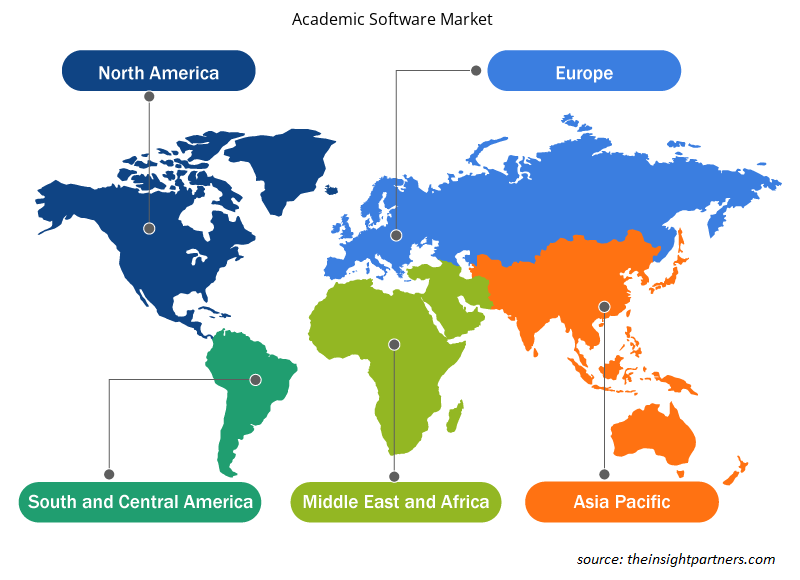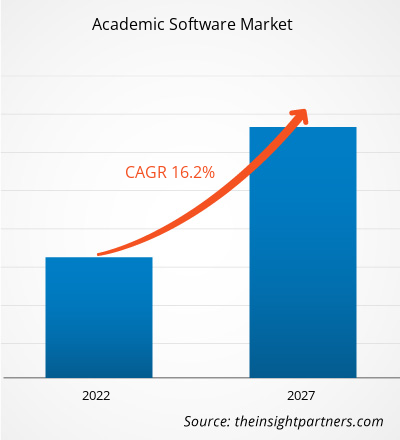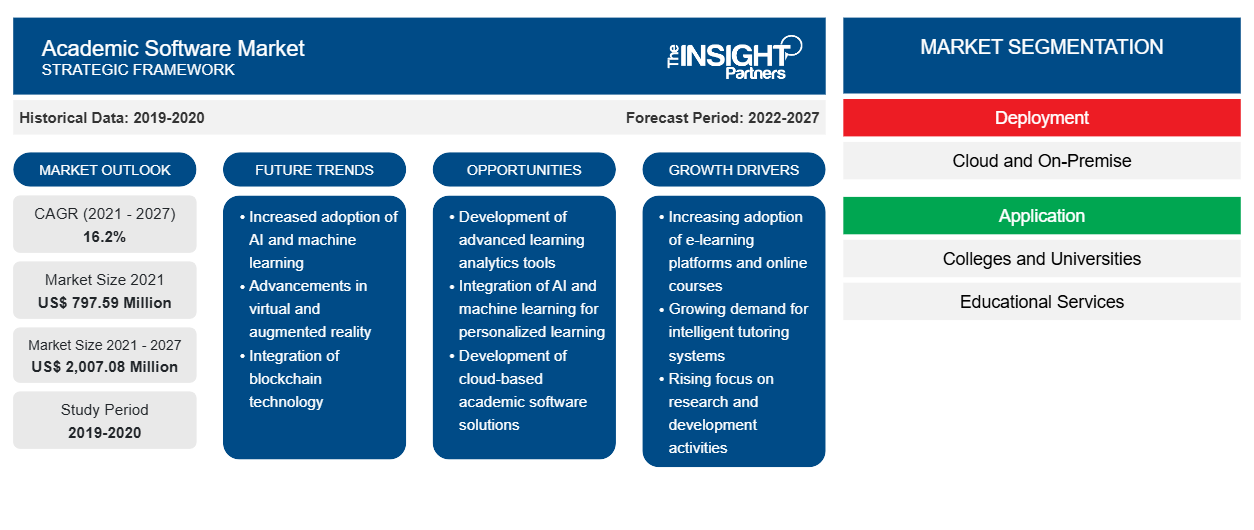学術ソフトウェア市場は、2021年の7億9,759万米ドルから2027年までに20億708万米ドルに成長すると予想されています。学術ソフトウェア市場は、2021年から2027年の予測期間中に16.2%のCAGRで成長すると予想されています。
教育機関全体で eLearning の採用が増えていることが、学術ソフトウェア市場の成長を牽引する主な要因です。eLearning では、コンテンツを読んだり見たりすることで、教育の提供方法が変わります。アニメーション、ポッドキャスト、ビデオなどのさまざまな eLearning コースは、マルチモーダルでリアルな学習環境を作り出します。eLearning の教育コンテンツは、コンピューター、ラップトップ、タブレット、スマートフォンを通じて、学習者にさまざまな没入型学習の機会を提供します。受動的な環境にいる代わりに、学生は学習する必要があるものを簡単かつ迅速に選択できます。これらの利点により、世界中で学術ソフトウェアの需要が高まっています。
COVID-19パンデミックは、世界中の教育分野に深刻な影響を及ぼしています。これにより、世界中のすべての主要経済国でオンライン教育システムの採用も促進され、遠隔地からの講義の配信、学生の管理、その他の運用活動など、さまざまなアプリケーション用のソフトウェアの採用に影響を与えています。したがって、分野全体で技術的に高度なソリューションの採用が増えることは、パンデミック中の学術ソフトウェア市場の成長にプラスの影響を与えると予想されます。
導入に基づいて、学術ソフトウェア市場はクラウドとオンプレミスに分かれています。2019年には、クラウドセグメントが市場で高いシェアを占めました。近年、テクノロジー業界ではクラウドベースのコンピューティングの採用が着実に増加しています。これは、クラウドベースのコンピューティングにより実装時間が簡素化され、導入コストが大幅に削減されるためです。この利点は多くのエンドユーザーを引き付けており、そのため、学術ソフトウェア市場のプレーヤーの大半は、クラウドベースのソフトウェアの需要の高まりに合わせてクラウドベースの製品を提供しています。さらに、先進国のインターネットインフラストラクチャは進化しており、多くの発展途上国で繁栄しており、エンドユーザーは先進国と発展途上国の両方でクラウドベースのソリューションにアクセスできます。
要件に合わせてレポートをカスタマイズする
このレポートの一部、国レベルの分析、Excelデータパックなど、あらゆるレポートを無料でカスタマイズできます。また、スタートアップや大学向けのお得なオファーや割引もご利用いただけます。
-
このレポートの主要な市場動向を入手してください。この無料サンプルには、市場動向から見積もりや予測に至るまでのデータ分析が含まれます。
学術ソフトウェア市場の洞察
人工知能などの技術と学術ソフトウェアソリューションの統合
人工知能 (AI) は、人間と同じように、コンピューターに人とコミュニケーションをとり、出来事を理解し、出来事を学習して反応する能力を与えるテクノロジーです。長年にわたり、人工知能はセキュリティや監視、情報技術などの業界全体で膨大なアプリケーションが採用されてきただけでなく、教育分野でもテクノロジーの採用が増加してきました。AI は、採点、財務分析、入学手続きなどの反復的なタスクを自動化するために、学校、大学、および総合大学全体で採用されています。たとえば、自動採点などの高度なコンピューター プログラムを通じて、採点中に教師の行動を学習してモデル化するように AI を調整し、将来的に自動的に成績を割り当てることができます。時間の経過とともに、プログラムは複数の学生の学力を学び、そのパフォーマンスに基づいてカスタマイズされたトレーニング プランを準備します。
展開ベースの市場洞察
導入タイプに基づいて、世界の学術ソフトウェア市場はクラウドとオンプレミスに分かれています。クラウドベースの学術ソフトウェアは、オンプレミスの学術ソフトウェアに比べて需要が高くなっています。クラウドセグメントは、先進国における強力なネットワークインフラストラクチャにより比較的安価であるため、需要の大部分を生み出しています。さらに、クラウドベースの学術ソフトウェアベンダーは、サイバー攻撃のリスクを排除するために、高度なセキュリティパッチの開発に重点を置いています。この要因もエンドユーザーからの大きな需要を生み出し、学術ソフトウェア市場を牽引しています。
アプリケーションベースの市場分析
アプリケーションに基づいて、学術ソフトウェア市場は大学、教育サービス、その他に分類されます。教育機関や大学でオンラインとオフラインの両方のコースを学生に提供するための最新ソリューションの導入が増えていることと、すべてのスタッフと学生が高度なソリューションを利用できるようにするための取り組みが、学術ソフトウェアの導入に影響を与えています。これが、長年にわたる市場の成長を後押ししています。
学術ソフトウェア市場で活動する企業は、学術ソフトウェア市場での地位を維持するために、市場イニシアチブ、買収、製品の発売などの戦略に重点を置いています。学術ソフトウェア市場の主要企業によるいくつかの開発は次のとおりです。
2020 年 12 月、Alma 学生情報システム プラットフォームは、成績表ツールに追加された成績平均点 (GPA) 機能を導入しました。標準ベースの評価 (SBG) は、複数のトピックや標準をカバーするために単一のスコアを使用するのではなく、指導および評価されている特定のスキルに対して学生のフィードバックと進捗状況の測定を一致させることに根ざしています。
2020 年 7 月、ConexED は iOS アプリ 2.2.3 を更新し、よりユーザーフレンドリーなエクスペリエンスを実現しました。このアプリにより、学生、スタッフ、教員はモバイル デバイスで仮想会議やビデオ会議に参加できます。
学術ソフトウェア市場の地域別分析
予測期間を通じて学術ソフトウェア市場に影響を与える地域的な傾向と要因は、Insight Partners のアナリストによって徹底的に説明されています。このセクションでは、北米、ヨーロッパ、アジア太平洋、中東およびアフリカ、南米および中米にわたる学術ソフトウェア市場のセグメントと地理についても説明します。

- 学術ソフトウェア市場の地域別データを入手
学術ソフトウェア市場レポートの範囲
| レポート属性 | 詳細 |
|---|---|
| 2021年の市場規模 | 7億9,759万米ドル |
| 2027年までの市場規模 | 2,007.08百万米ドル |
| 世界のCAGR(2021年~2027年) | 16.2% |
| 履歴データ | 2019-2020 |
| 予測期間 | 2022-2027 |
| 対象セグメント |
展開別
|
| 対象地域と国 |
北米
|
| 市場リーダーと主要企業プロフィール |
|
学術ソフトウェア市場のプレーヤー密度: ビジネスダイナミクスへの影響を理解する
学術ソフトウェア市場は、消費者の嗜好の変化、技術の進歩、製品の利点に対する認識の高まりなどの要因により、エンドユーザーの需要が高まり、急速に成長しています。需要が高まるにつれて、企業は提供内容を拡大し、消費者のニーズを満たすために革新を起こし、新たなトレンドを活用し、市場の成長をさらに促進しています。
市場プレーヤー密度とは、特定の市場または業界内で活動している企業または会社の分布を指します。これは、特定の市場スペースに、その市場規模または総市場価値に対してどれだけの競合相手 (市場プレーヤー) が存在するかを示します。
学術ソフトウェア市場で事業を展開している主要企業は次のとおりです。
- アルマ
- キャンパスカフェソフトウェア
- コネックスED
- エンビジオソリューションズ株式会社
- フルファブリック
免責事項:上記の企業は、特定の順序でランク付けされていません。

- 学術ソフトウェア市場のトップキープレーヤーの概要を入手
学術ソフトウェア市場 – 導入別
- 雲
- オンプレミス
学術ソフトウェア市場 – アプリケーション別
- 大学
- 教育サービス
- その他
学術ソフトウェア市場 – 地域別
-
北米
- 私たち
- カナダ
- メキシコ
-
ヨーロッパ
- フランス
- ドイツ
- ロシア
- 英国
- イタリア
- その他のヨーロッパ
-
アジア太平洋(APAC)
- 中国
- インド
- 日本
- オーストラリア
- 韓国
- その他のアジア太平洋地域
-
外務省
- サウジアラビア
- アラブ首長国連邦
- 南アフリカ
- MEAの残り
-
サム
- ブラジル
- アルゼンチン
- 残りのSAM
学術ソフトウェア市場 – 企業プロファイル
- アルマ
- キャンパスカフェソフトウェア
- コネックスED
- エンビジオソリューションズ株式会社
- フルファブリック
- PowerVista Software 社
- クアルトリクスLLC
- トップハットモノクル社
- トゥルーダイアログ
- ワイズハイブ
- 過去2年間の分析、基準年、CAGRによる予測(7年間)
- PEST分析とSWOT分析
- 市場規模価値/数量 - 世界、地域、国
- 業界と競争環境
- Excel データセット
最新レポート
関連レポート
お客様の声
購入理由
- 情報に基づいた意思決定
- 市場動向の理解
- 競合分析
- 顧客インサイト
- 市場予測
- リスク軽減
- 戦略計画
- 投資の正当性
- 新興市場の特定
- マーケティング戦略の強化
- 業務効率の向上
- 規制動向への対応























 無料サンプルを入手 - 学術ソフトウェア市場
無料サンプルを入手 - 学術ソフトウェア市場